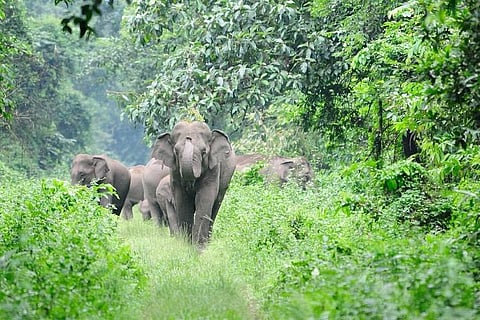

Nearly a week ago, three elephants, including two adults and one calf, came out of the forest near the Mundoor forest area.
They have since been spotted several times around Palakkad and Thrissur districts. The wild animals roaming freely near human habitats are causing a scare among people in the region. All efforts to send them back have gone in vain.
The elephants were first spotted by devotees visiting Ivor Madom temple for the Bali Tharppanam ritual in Thiruvilwamala.
Later, they moved to a plantation in Perigottukurussi.
They were seen taking a bath in the Bharathapuzha river. They were also found easily moving through human inhabited areas without any fear.
The elephants damaged the gate of a pump house in Pampady and entered the compound.
Section 144 was imposed from Tuesday to Thursday in some densely populated areas. All schools in Thiruvilwamala, Kuthampully, and Mayannur declared a holiday for three days.
On Thursday morning, the animals were found near the Mangara railway station.
Forest officials are still trying to get the elephants to move towards the forest.
They have been using rubber bullets as well as crackers to lead them to the Mundoor forest area which 15 kilometres away.
According to the officials, since there are three elephants, using tranquilisers is not a practical idea.
Though there were initial plans to bring 'kumi' elephants to tame the wild tuskers, later this too was found to be impractical as the officers feared that the animals may run amok.
As of now, no human casualties have been reported, but the elephants have caused damage to crops.
Reason
Lack of enough food inside the forest and rising temperatures due to climate change could be forcing the tuskers to move out of the forest, some people say.
But Dr PS Easa, an expert in wildlife biology, conservation biology and conservation of Asian elephants has a different theory. He says man-animal conflict was earlier referred to as man-animal interaction.
"During the monsoons, the water sources in the forest will have plenty of water. So water and food are not reasons for them to venture out. Usually, elephant herds are controlled by the females. But when a male elephant is 12 or 13 years old, it has a tendency to explore things and move out of its herd," he says.
"These elephants can form a group of their own and will also have their own leader. And if the leader is mischievous, he will bring the herd outside the forest. And sometimes when they explore outside their natural territory, they may reach human habitations," Easa added.
Often crop farms can attract female elephants due to the easy availability of food. "Moreover, cultivations close to forest look similar to the jungle and so the animals don't see any difference," he said.
Easa also mentioned that wild animals have a tendency to move around after breeding and it is human beings who are intolerant in nature.